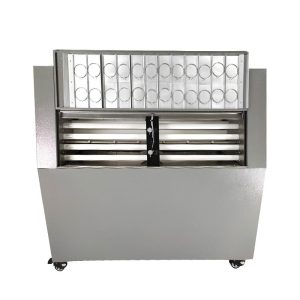Weatherability of pe pipe and its detection method
Measuring the weather resistance of polyethylene (PE) pipes is very important, as PE pipes are widely used in water supply, drainage, natural gas transmission, and industrial pipelines, which need to be able to resist the erosion of various factors such as ultraviolet radiation, temperature changes, humidity, chemicals, and mechanical stresses for a long time. Weather resistance testing can help evaluate the stability, physical properties, and service life of PE pipes under these conditions to ensure that they can maintain good performance and reliability in the application.
Method of test
Accelerated aging test: use simulated accelerated aging equipment, such as ultraviolet radiation lamp or constant temperature and humidity box, to expose PE pipe samples for a certain time. The weatherability of PE pipes is evaluated by observing phenomena such as appearance change, color stability, surface cracking, peeling, or other shape changes.
Physical property test: measure the physical properties of PE pipe samples, such as strength, hardness, impact resistance and wear resistance. By comparing the test results at different time points, whether the physical properties of PE pipes are affected by weathering conditions is evaluated.
Dimensional stability measurement: Measure the dimensional changes of PE pipe samples, including parameters such as length, diameter and wall thickness. The dimensional stability and change of PE pipes were evaluated by comparing the measurement results at different time points.
Weatherability of pe pipe and its detection method
Chemical property analysis: Chemical analysis methods, such as infrared spectroscopy (FTIR) or nuclear magnetic resonance (NMR), are used to detect the changes in the chemical properties of PE pipe samples under weather resistant conditions. Observe whether changes in molecular structure, breaks in chemical bonds, or the formation of decomposition products occur.
Rupture strength test: use pressure tester or extension tester to apply internal pressure or external force to PE pipe sample to measure its rupture strength. By comparing the test results at different time points, the weatherability and rupture resistance of PE pipes were evaluated.
Long-term buried test: PE pipe samples are buried in soil or water, exposed to the actual environment for a period of time, and observe its performance and appearance changes. The weatherability of PE pipes under actual use conditions was evaluated by comparing the observations from different time periods.

Through the above methods, the weather resistance of PE pipe can be comprehensively evaluated, and its stability, physical properties and service life under different environmental conditions can be understood. This helps to improve the quality and reliability of PE pipes, ensuring that they can maintain good performance and safety for a long time in applications such as water supply, drainage, natural gas transmission, and industrial piping. Please note that specific test methods and standards may vary depending on different PE pipe types and application requirements. Therefore, it is recommended to refer to relevant standards and specifications and consult professional laboratories or testing institutions for more specific and accurate advice before conducting tests.
